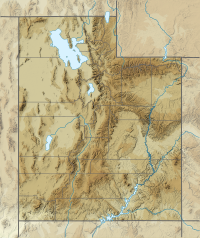This article needs additional citations for verification. (May 2021) |
| Fish Springs Range | |
|---|---|
 northeast hills of Fish Springs Range (from Fish Springs) | |
| Highest point | |
| Peak | George H. Hansen Peak, Fish Springs Range-(center, slightly south) |
| Elevation | 5,686 ft (1,733 m) |
| Coordinates | 39°43′30″N 112°26′25″W / 39.72490°N 112.4404°W |
| Dimensions | |
| Length | 16 mi (26 km) N-S |
| Width | 4 mi (6.4 km) (at center-south, elsewhere 3-mi surrounded by salt flats or flatlands) |
| Geography | |
| Country | United States |
| State | Utah |
| Regions | (Great Basin Desert) (southern)-Great Salt Lake Desert |
| County | Juab |
| Community | Fish Springs (site) |
| Borders on | Snake Valley-NW (Deep Creek Range-NW) Great Salt Lake Desert-NNW, N & NNE Fish Springs National Wildlife Refuge-NE-(attached) (Dugway Range-NE) Fish Springs Flat-E (Thomas Range-E) House Range-SSE Tule Valley-S Snake Valley-W |
The Fish Springs Range is a 16-mile (26 km) long narrow, and north-trending mountain range located in center-west Juab County, Utah. The northeast of the range borders the Fish Springs National Wildlife Refuge; the entire east of the range borders the Fish Springs Flat, where the east region of the flat borders the Thomas Range.
The Fish Springs Range lies at the south of the Great Salt Lake Desert; southwards, as well as southwest and southeastwards, north-trending valleys and mountain ranges drain northwards to the Great Salt Lake Desert. The sequence of these landforms west-to-east, are Snake Valley (Great Basin), Confusion Range, Tule Valley-(Fish Springs Range-north), House Range, Whirlwind Valley, and Drum Mountains.
The south of the range borders the north of Tule Valley.
